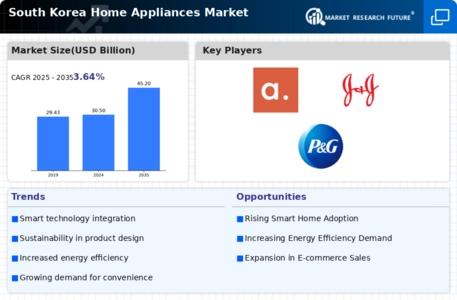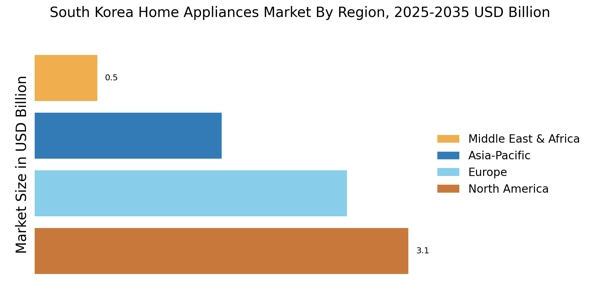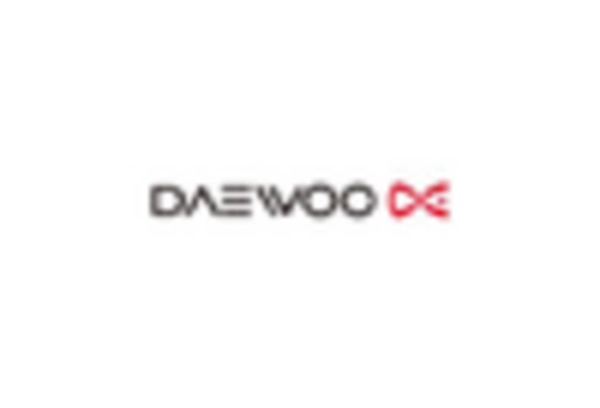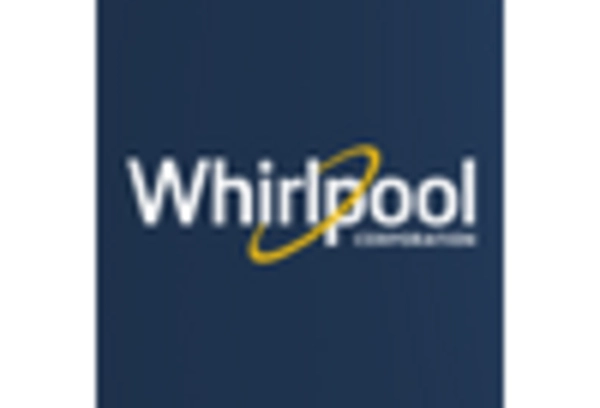The South Korea Home Appliances Market is characterized by a dynamic competitive landscape, driven by rapid technological advancements and evolving consumer preferences. Major players such as Samsung Electronics (KR), LG Electronics (KR), and Bosch (DE) are at the forefront, each adopting distinct strategies to enhance their market positioning. Samsung Electronics (KR) emphasizes innovation through its smart home ecosystem, integrating IoT capabilities into its appliances, thereby appealing to tech-savvy consumers. LG Electronics (KR) focuses on sustainability, launching energy-efficient products that resonate with environmentally conscious buyers. Meanwhile, Bosch (DE) leverages its reputation for quality and reliability, targeting the premium segment with high-end appliances that combine functionality with design. Collectively, these strategies contribute to a competitive environment that prioritizes technological integration and consumer-centric solutions.
Key business tactics within the South Korean home appliances sector include localizing manufacturing and optimizing supply chains to enhance efficiency and responsiveness. The market structure appears moderately fragmented, with several key players exerting significant influence. This fragmentation allows for a diverse range of products and innovations, fostering competition that drives continuous improvement and adaptation among manufacturers.
In August 2025, Samsung Electronics (KR) announced a partnership with a leading AI firm to enhance its smart appliance capabilities. This collaboration aims to integrate advanced AI features into its product line, enabling appliances to learn user preferences and optimize energy consumption. Such a strategic move not only reinforces Samsung's commitment to innovation but also positions it favorably against competitors in the increasingly tech-driven market.
In September 2025, LG Electronics (KR) unveiled its new line of eco-friendly appliances, which utilize recycled materials and energy-efficient technologies. This initiative aligns with global sustainability trends and reflects LG's strategic focus on reducing its carbon footprint. By prioritizing sustainability, LG not only meets regulatory demands but also appeals to a growing segment of consumers who prioritize environmental responsibility in their purchasing decisions.
In October 2025, Bosch (DE) launched a new marketing campaign aimed at promoting its premium appliances, highlighting their durability and energy efficiency. This campaign is significant as it seeks to differentiate Bosch's offerings in a crowded market, emphasizing quality over price. By reinforcing its brand identity as a provider of high-quality appliances, Bosch aims to capture a larger share of the premium market segment, which is increasingly attractive to discerning consumers.
As of October 2025, current competitive trends in the South Korean home appliances market are heavily influenced by digitalization, sustainability, and the integration of artificial intelligence. Strategic alliances among companies are shaping the landscape, enabling them to pool resources and expertise to innovate more effectively. Looking ahead, it is likely that competitive differentiation will increasingly pivot from price-based strategies to those centered on innovation, technological advancement, and supply chain reliability. This shift suggests that companies that can effectively leverage these trends will be better positioned to thrive in an evolving market.


















Leave a Comment